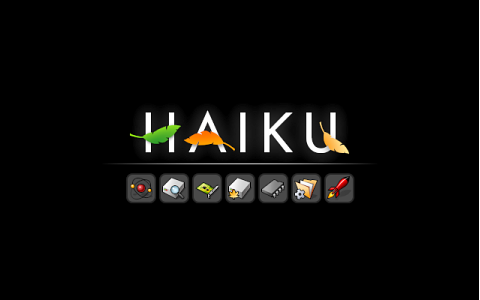Cargador de arranque
Haiku's Boot Loader Options can help when you experience hardware related problems or want to choose which Haiku installation to start, if you have more than one (maybe on an installation CD or USB stick). It's also handy if you have installed a software component that acts up and prevents you from booting Haiku, see Troubleshooting below.
Para visualizar las opciones del cargador de arranque, hay que mantener presionada la techa SHIFT (de mayúsculas) antes del comienzo del proceso de arranque de Haiku. En de haber un administrador de arranque instalado, empiece a presionar la tecla antes de seleccionar Haiku desde el mismo. Si Haiku es el único sistema operativo instalado, empiece a presionar la tecla mientras se viualizan los mensajes de arranque del BIOS.
 Opciones del Cargador de Arranque
Opciones del Cargador de Arranque
Una vez allí, se le ofrecerán tres menús:
| Seleccionar volumen de arranque | Choose which Haiku installation/state to start (see Troubleshooting below). | |
| Seleccionar opciones de modo seguro | Existen muchas opciones para probarse en caso de que tenga un problema de hardware o si el sistema se vuelve inestable o no arranca por una extensión (add-on) con comportamiento indebido. Al mover la barra de selección a una opción, una pequeña explicación aparecerá en la parte inferior de la pantalla. | |
|
| ||
| Select debug options | Here you'll find several options that help with debugging or getting details for a bug report. Again, a short explanation for each option is displayed at the bottom. | |
|
| ||
| If is activated, a warm reboot after a crash shows these additional options: | ||
|
| ||
| Select screen resolution | Lets you force a certain screen resolution and color depth. |
 Troubleshooting
Troubleshooting
If Haiku refuses to boot on your hardware from the get-go, try out setting different options under . Consider filing a bug report in any case.
On the other hand, if Haiku only suddenly acts up after you have installed some software, especially hardware drivers, you have several options to get Haiku bootable again so you can uninstall the offending package:
Activating will prevent most servers, daemons and the UserBootscript from being started.
Activating will prevent using any add-ons (drivers, translators, etc.) you have installed in the user hierarchy under your Home folder.
If the offending driver, add-on etc. is installed in the system hierarchy, things get a bit more complicated, because that area is read-only. Here, the comes into play. With it, you can navigate through the whole system hierarchy and disable the component that's messing things up for you by checking an entry with the SPACE or RETURN key. ESC returns you up one level to the parent directory.
Online, there's the article How to Permanently Blacklist a Package File showing how to make that setting stick.
Under you can specify what former "version" of Haiku to boot. Every time you un/install a package, the old state is saved and you can boot into it by choosing it from the list presented in the boot loader options.
So, if you encounter boot problems after installing some package, boot a Haiku state from before that time and uninstall the offending package.
 Booting Haiku
Booting Haiku
After activating one or more options, you return to the main menu and continue booting, which presents you with this boot screen:

If everything works OK, one symbol after another quickly lights up.
The different symbols roughly correspond to these boot stages:
| Atom | Initializing modules. | |
| Disk + magnifier | Creating rootfs (/) and mounting devfs (/dev). | |
| Plug-in card | Initializing device manager. | |
| Boot disk | Mounting boot disk. | |
| Chip | Loading CPU specific modules. | |
| Folder | Final initialization of subsystems. | |
| Rocket | Launch_daemon has started the system. |
 Español
Español Català
Català Deutsch
Deutsch English
English Français
Français Italiano
Italiano Magyar
Magyar Polski
Polski Português
Português Português (Brazil)
Português (Brazil) Română
Română Slovenčina
Slovenčina Suomi
Suomi Svenska
Svenska 中文 [中文]
中文 [中文] Русский
Русский Українська
Українська 日本語
日本語